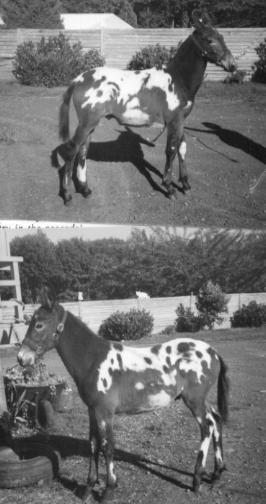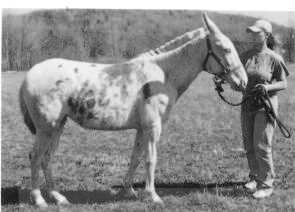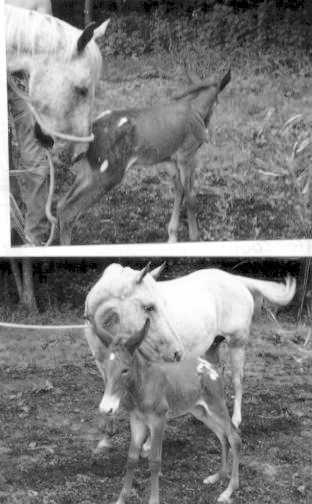The Mule is a cross between a donkey stallion (called a jack) and a horse mare. Hinnies are just the opposite - a stallion horse crossed to a donkey jennet. For all purposes, hinnies and mules are classified and shown together under the general term Mule. Mules ears are usually somewhat smaller than a donkeys, longer but the same shape as the horse parents. The mule's conformation will be a combination of traits from both parents. The head, hip and legs usually take after the jack. Mules do not have pronounced arches to the neck, even from breeds such as Arabians or Warmbloods. A slight arch or straight neck is preferable to a ewe, or upward curved neck.
The mule will have "combination hair", usually a thin forelock, coarse mane hair, and a tail more like the horse parent. Both mules and donkeys are shown with a variety of hairstyles from clipped to shaved (roached). Mules may wear their tails "belled" as decoration, left long and full, or clipped at the top to emphasize the shape of the hip.
Mules try their best to imitate the donkey's bray, but most have a unique sound that is a combination of the horse?s whinny and the grunting of the wind-down of a bray. Most will start out - "Whineeeeee" and end in "aw ah aw". Every mule or hinny will have a unique bray.
Mules usually have brown or tan-colored "points" (Around the eyes, the muzzle, and sometimes belly and flanks) , where in the donkey the Light Points are a shade of off-white. Some donkeys and mules do not exhibit any light points at all - this is not usual (due to a recessive gene) , but is a good identification marker for registration purposes. Old-timers used to call a dark muzzled mule "blue nosed". Mules can be any of the colors that either horses or donkeys come in, along with some unique variations of their own. The only colors mules do NOT come in is true horse pinto (due to the genetic factoring of these colors, there are some mules who are close to, but not quite, tobiano patterned, and none recorded in Overo). Mules from Appaloosa mares often have extremely loud patterns, with spots enlarging or "skewing" in variants of the horse appaloosa. Breeders wishing for a mule with four white feet should try a tobiano mare. The mule will probably have four socks and/or stockings, with the most usual combination being four white feet and a splash of whit on the tail. The genes of the mule seem programmed for the unusual, and very strange, loud spotted pinto and appaloosa variants are common. In fact, the best way to produce a spotted mule is to cross a spotted jack to a solid colored mare. The resulting mule may have pinto-like patched in a variation of the donkey-spot pattern. Appaloosa mares crossed to spotted jacks have often produced mule foals that appear to be roan-patched pinto, with dark leopard appaloosa spots over the dark areas.
Mules come in every size and shape imaginable. Miniature mules (even to under 36") can be seen all the way up to 17 hand Percheron draft (by Mammoth Jacks) Mules. The Poitou donkey was used exclusively for breeding huge draft mules from a breed of draft horse called the Mullasier - the Mule producer. The build of the mule is a combination of both parents. The head resembles both, the eyes being more almond-shaped (inherited from the D-shaped eye socket of the donkey). Male mules may have more prominent brow ridges like those of most donkey jacks. The neck is straight and has little arch, even in mules from Arab or Warmblood mares. The overall body shape will be dependent on the conformation of both parents. Due to hybrid vigor, the mule has the possibility of growing taller than either parent.
The rarer Hinnies are often said to be more horselike than the mule, but more often it is impossible to tell them apart. Hinnies may tend to be slightly smaller, simply because of the fact that most donkeys are smaller than horses. Mules can be used in exactly the same sports as horses - under saddle, in harness, for cutting, roping or dressage. In actuality, they have more stamina and can carry more eight than a horse of equal size. This is due to the hybrid vigor. There is one particular aspect where the mule actually outshines the horse, and that is high-jumping. Mules have a particular sport all their own called the Coon Hunter's Jump. It stems from the raccoon hunter moving his saddle and pack mules through the woods. Wooden or stone fences could be taken down, but wire ones could not. The hunter would flag the fence with his coat or a blanket, and jump his string of pack mules over one by one. In the showring, mules jump a single rail standard to increasing heights. The last clean jump is the winner. Mules only 50 inches tall at the withers have been known to clear jumps of up to 72 inches. These jumps are not from a galloping approach, like Puissance, but from a standing start inside a marked area. Truly a remarkable feat.
Mules are not really stubborn. They can seem lazy, but they will also not put themselves in danger. A horse can be worked until it drops, but not so with a mule. The "stubborn" streak is just the mule's way of telling humans that things are not right. Mules are very intelligent and it is not a good idea to abuse a mule. They will do their best for their owner, with the utmost patience.
Mules in the USA are classified by size.
Under 50" - Miniature Mules. Some Miniature Mules are truly tiny - most people think of Mini mules in the same catagory as Miniature Horses and Miniature Donkeys as being under 36 or 38 ", but the teamsters using mini mules for pulls and hauling set the height many years ago at 50".
Work Mule - Over 50" in height, of a build suitable for working but not usually as refined as a Saddle Mule. May have a smaller draft mare as a parent.
Saddle Mule - any height over 50.01" and can even be up to 17+ hands. Usually of Mammoth/ Saddle type horse breeding - Arabian, Stock, Gaited, or any other saddle horse. The jack sire might be a Mammoth jack but could be a large Standard.
Draft Mule - Mules from Draft Horse dams. Usually sired by large, heavy Mammoth jacks.
Race Mules - Mules of any size or breeding (with the exception usually being Draft breeds) that can scoot! No requirements on breeding although they are usually from Quarter, Paint, Appaloosa, or Thoroughbred stock. No known height requirements, either, but usually over 13 hands in height.




(sorry about the black & white photo).
Miniature Donkeys Standard Donkeys
Mammoth Jackstock
Longeared Hybrids - Mules and Hinnies
FAQ about Showing and Registration
FAQ about Color COLOR Definitions
Spotted Asses Breeding for Spots
Photos. Mule Coloration
the ADMS Zebrass?
Links Hee Haw Books
Fun Transporting
Mini donkeys at Calgary
Tail-less donkeys?
